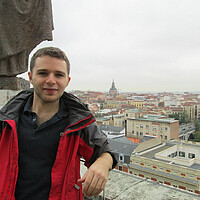In Arabic and Hebrew media, the 'other' is absent
Loading...
Arabic and Hebrew media depictions of the ongoing conflict between Israel and Hamas contrast starkly, with most publications calling for violent retribution and leaving certain narratives unheard.
In their coverage of the current conflict, Israeli and Palestinian media outlets have emphasized their own people's trauma, downplaying or even failing to acknowledge consequences and pain for the other side.
"Anecdotes are non-existent of Palestinian suffering," says Seth Frantzman, an editor at the English-language Jerusalem Post, of Israeli media's coverage. “Even though we’re the most covered place on earth, people often drop the ball and don't see nuance or don’t adequately investigate issues related to the conflict."
Few Hebrew language articles have an on-the-ground view from Gaza, and headlines rarely mention the fact that the assault has led to Palestinian deaths.
The banner headline from Israeli newspaper Maariv read "The country is under fire." A front-page op-ed in the English-language edition of Israel Hayom (Israel Today), the right-leaning, highest circulation tabloid, is headlined "Return Gaza to the Stone Age." Written by Amos Regev, the paper’s editor-in-chief, the article called for a "a massive concentration of force." The top headline in the Hebrew edition read "Go all the way."
Most papers led with pictures of Israelis huddling in bomb shelters and lying beneath stalled cars on the highway. The few photos of Gaza that appeared include aerial shots of pummeling smoke with no specific debris of human scale.
Anchors on Israeli television networks have reiterated the call-to-arms and that Israel should not be forced to suffer rocket fire. Few if any Palestinian or left-leaning guests have appeared on news programs.
But Arabic media outlets weren't even-handed either. They highlighted Israel’s attack on Gaza without mentioning the hundreds of rockets that have been fired on Israel this week alone. There have been no Israeli casualties, due partially to imprecise firing of rockets and partly to Israel's Iron Dome missile defense system.
"Israel continues to kill children and women," read the top headline of Al-Ayyam, a Palestinian paper based in Ramallah. Maan News Agency, a Palestinian media outlet, labeled both the Palestinian militant and civilian dead as "martyrs." Al-Quds, the Jerusalem-based, most-read Palestinian broadsheet, dubbed the weapons "resistance rockets" in its news coverage.
Since the beginning of the Israeli aggression on the Gaza Strip, 82 civilians have been killed and hundreds wounded, while the resistance rockets have aimed at Haifa and Hadera, Jerusalem, Tel Aviv and Dimona.
The official newspaper of the Palestinian Authority, Al-Hayat al-Jadida, published a more balanced take, acknowledging the Israelis huddling in bomb shelters. The article noted that rockets "prompted Israel to open all shelters from the south to Haifa in the north" and mentioned American and European condemnation of Hamas rocket fire.
Among Israeli media, left-leaning Haaretz has been an outlier, publishing an analysis questioning the end goal of the military operation.
It seems as if Prime Minister Benjamin Netanyahu is approaching the point of having to decide between two rather unpleasant options: Further intensifying the air strikes and risking another Goldstone Report, or sending a mass of ground forces into the Strip without being certain of what their objective is.







